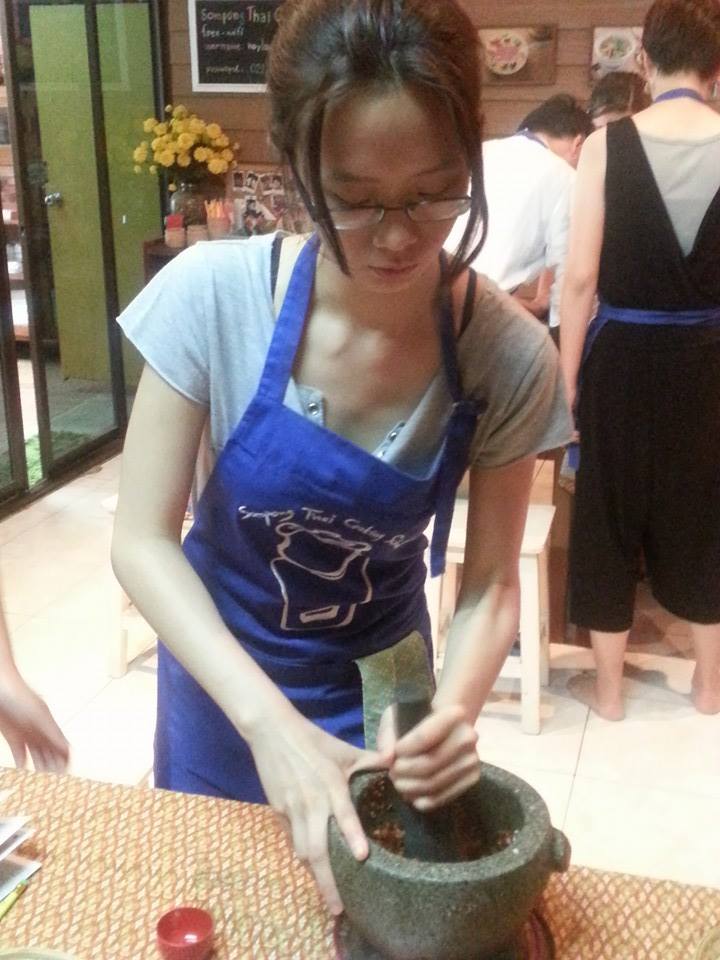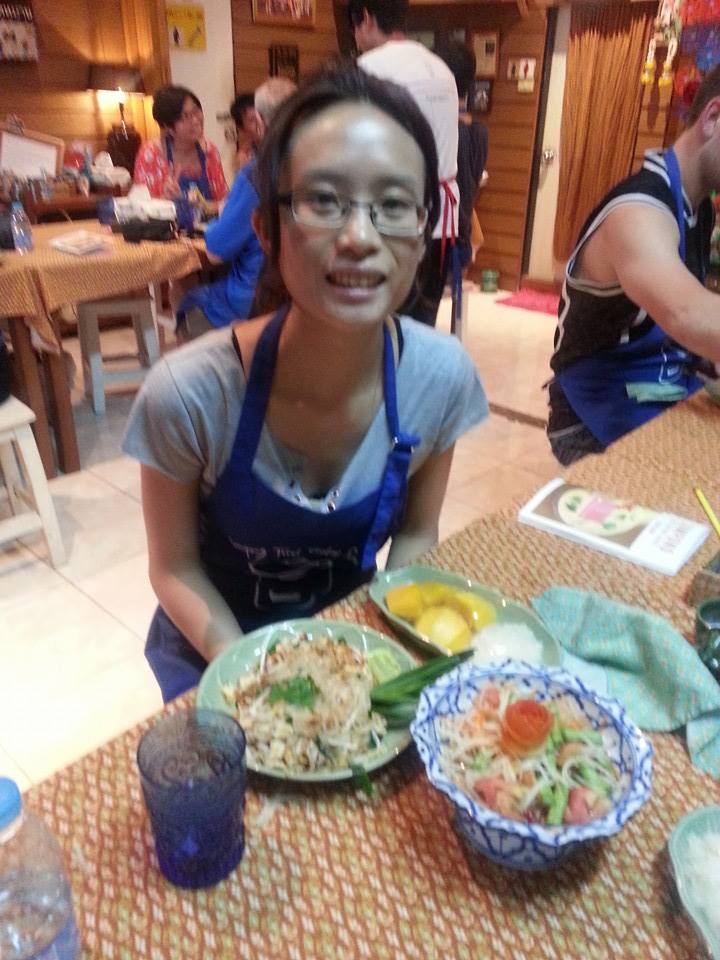I have always wanted to take Thai culinary training because unlike cooking classes in other countries, Thai cooking schools are very hands on and make sure that not only do you make curry pastes and sauces from scratch, you also visit local markets so you can see and feel the many ingredients that you work with to make your delicious 4-course meal in 4 hours.
When I saw Soompong Thai Cooking School’s website online and that they accommodate my peanut allergies, I immediately signed up for their class. (FYI, I took the Wednesday class).
Once we were picked up at Chong Nonsi BTS station, we began a local market tour of the ingredients used.

Coconut is shredded in machine and then vendor puts shreds into other machine to turn it into coconut paste.
We began making our first dish: Panang Curry Chicken. Because I am allergic to peanuts, I can only make red curry as panang curry paste contains peanuts.
Red curry is made up of galangal (Thai ginger), kaffir lime skin (not the lime, just the skin), coriander seeds and roots, shallot, shrimp paste, garlic, shallots, cumin seeds ,lemongrass and peppercorns. With the traditional way you smash the dry ingredients, herbs then juicy ingredients with pestle in the mortar, or you can do it with a blender. But the key point is to blend all the ingredients.
However, it takes more than the curry paste to make the red curry chicken.
Curry paste is not complete without coconut paste. After it is mixed with coconut paste, then comes the cooking and simmering of chicken. Afterwards, sprinkle with kaffir lime leaves and red chillies and serve with rice with a dash of coconut milk if you prefer a creamier texture.
NB: Important difference between coconut paste and coconut milk. Coconut paste is much thicker and creamier, coconut milk can be made by diluting coconut paste with 1/2 cup of water.
The next dish is Som Tum (Papaya Salad). The dish is relatively easy to make, but the making of the sauce and styling of the salad are also arts in themselves.
Similar to the red curry, lime, fish sauce, dried shrimp, sugar, garlic and chili are mixed and crushed in the mortar. Then long beans, green papaya, carrots and tomatoes are shredded, cut and mixed. A tip on the tomato flower is to cut the tomato skin and twirl it.

And how can Thai cuisine be complete without pad thai (stir fry noodles) and mango sticky rice?
Many people often believe that pad thai should look orange, but it is because they used dried shrimps with coloring. Pad thai is really thin rice noodles stirred fried with sauce and egg. The seasoning, composed of chili, white sugar, palm sugar, tamarind paste, oyster sauce and fish sauce are mixed together in the mortar.
Like Chinese cooking, garlic and shallots are cooked first for the fragrance, then we added the shrimp/chicken and the egg. Noodles and water are then added once the egg was cooked and set aside on one side of the wok, and after the noodles are softened, add the pad thai sauce and mix everything! To top it off, there is always coriander seeds, lime and chives.
Mango sticky rice is probably the easiest to make, but getting sticky rice is hard. Once the sticky rice is cooked, soak it with coconut topping (coconut paste and white sugar), then cut the mangoes and there we go.
4 hours of amazing culinary training is totally worth it with this delicious lunch! And a huge thank you to all the staff for the accommodations. guidance and the cook book!
A few notes and substitutions though:
* Shrimp can be taken out of pad thai and som tum for vegetarian options.
* Curry pairings: Red and panang curries work well with beef and chicken, but green curry works better with chicken.
* Always, always have honey or lemongrass tea to cool off all the spice from the curry. I know this is more of a Chinese saying, but if you are not used to having Thai curry in your diet, it is better to have something to cool off the spice.
* Don’t substitute ginger with galangal as flavour is different.
* With chili, remove seeds to reduce spiciness and tamarind plant can be soaked to produce tamarind juice that make the paste.
Sompong Thai Cooking school, 31/11 Silom Soi 13 , Silom Road,Bangrak Bangkok, Thailand 10500
+662-233-2128






